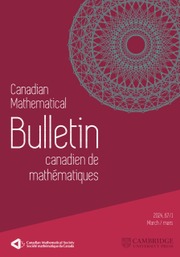Article contents
Constructing Double Magma on Groups Using Commutation Operations
Published online by Cambridge University Press: 20 November 2018
Abstract
A magma  $\left( M,\star\right)$ is a nonempty set with a binary operation. A double magma
$\left( M,\star\right)$ is a nonempty set with a binary operation. A double magma  $\left( M,\star ,\bullet\right)$ is a nonempty set with two binary operations satisfying the interchange law
$\left( M,\star ,\bullet\right)$ is a nonempty set with two binary operations satisfying the interchange law  $\left( w\star x \right)\bullet \left( y\star z \right)=\left( w\bullet y \right)\star \left( x\bullet z \right)$ . We call a double magma proper if the two operations are distinct, and commutative if the operations are commutative. A double semigroup, first introduced by Kock, is a double magma for which both operations are associative. Given a non-trivial group
$\left( w\star x \right)\bullet \left( y\star z \right)=\left( w\bullet y \right)\star \left( x\bullet z \right)$ . We call a double magma proper if the two operations are distinct, and commutative if the operations are commutative. A double semigroup, first introduced by Kock, is a double magma for which both operations are associative. Given a non-trivial group  $G$ we define a system of two magma
$G$ we define a system of two magma  $\left( G,\star ,\bullet\right)$ using the commutator operations
$\left( G,\star ,\bullet\right)$ using the commutator operations  $x\star y=\left[ x,y \right]\left( ={{x}^{-1}}{{y}^{-1}}xy \right)$ and
$x\star y=\left[ x,y \right]\left( ={{x}^{-1}}{{y}^{-1}}xy \right)$ and  $x\bullet y=\left[ y,x \right]$ . We show that
$x\bullet y=\left[ y,x \right]$ . We show that  $\left( G,\star ,\bullet\right)$ is a double magma if and only if
$\left( G,\star ,\bullet\right)$ is a double magma if and only if  $G$ satisfies the commutator laws
$G$ satisfies the commutator laws  $\left[ x,y;x,z \right]=1$ and
$\left[ x,y;x,z \right]=1$ and  ${{\left[ w,x;y,z \right]}^{2}}=1$ . We note that the first law defines the class of 3-metabelian groups. If both these laws hold in
${{\left[ w,x;y,z \right]}^{2}}=1$ . We note that the first law defines the class of 3-metabelian groups. If both these laws hold in  $G$ , the double magma is proper if and only if there exist
$G$ , the double magma is proper if and only if there exist  ${{x}_{0}},{{y}_{0}}\in G$ for which
${{x}_{0}},{{y}_{0}}\in G$ for which 
 $G$ is nilpotent of class two. We construct a specific example of a proper double semigroup based on the dihedral group of order 16. In addition, we comment on a similar construction for rings using Lie commutators.
$G$ is nilpotent of class two. We construct a specific example of a proper double semigroup based on the dihedral group of order 16. In addition, we comment on a similar construction for rings using Lie commutators.
Information
- Type
- Research Article
- Information
- Copyright
- Copyright © Canadian Mathematical Society 2015
References
- 1
- Cited by

